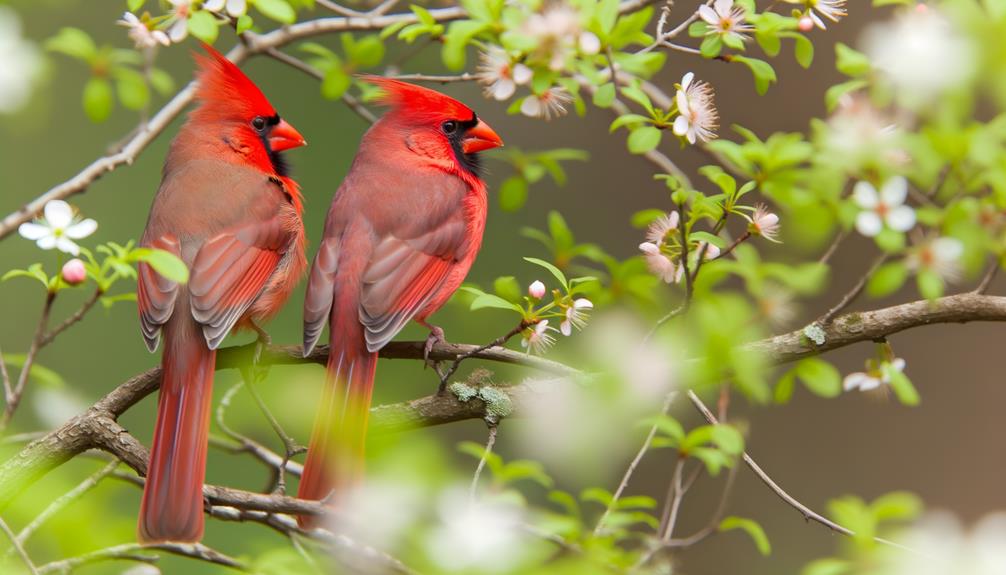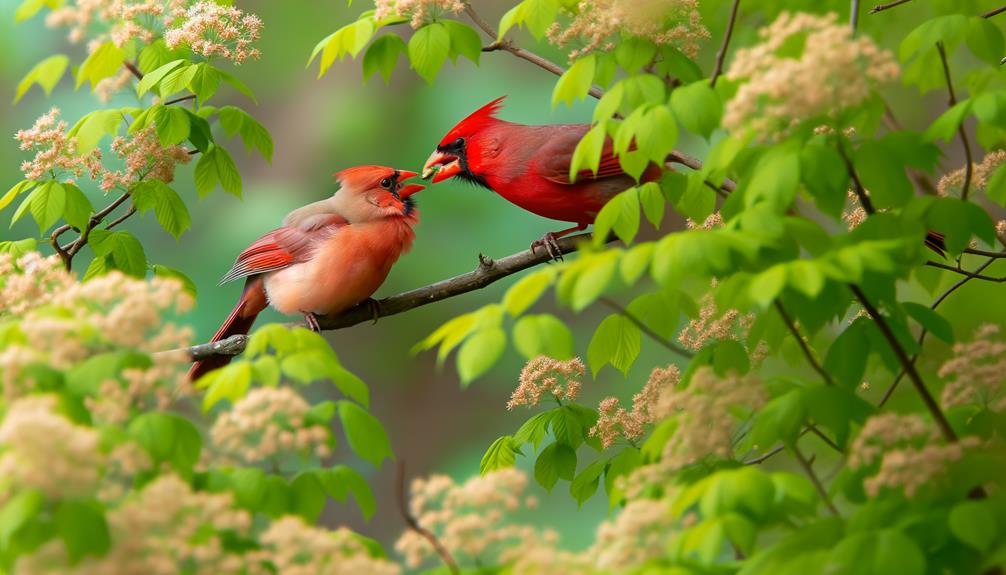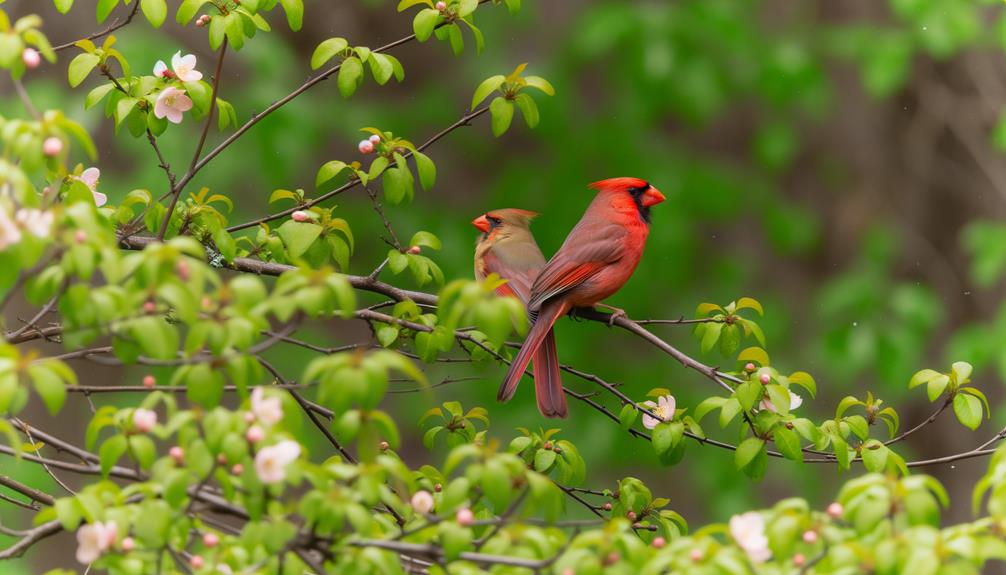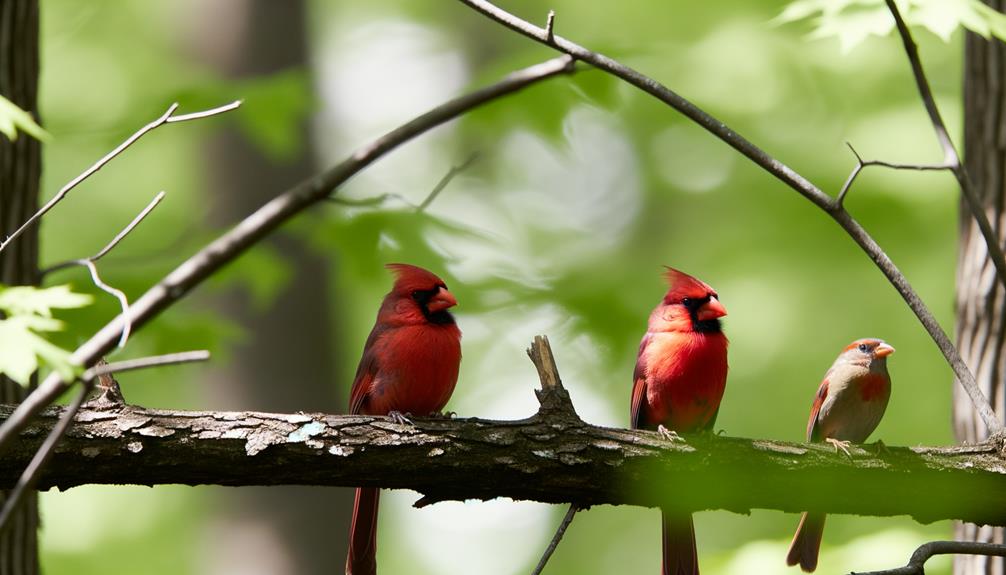Do Northern Cardinals Mate for Life?
Northern Cardinals generally form monogamous pair bonds that can endure several breeding seasons. Their courtship involves complex rituals, including singing, feeding seeds, and mutual preening, which strengthen their bond.
Both males and females actively participate in nest construction and defending their territory. They select dense shrubs or low branches to build their nests, ensuring safety from predators.
Mated pairs usually stay together year-round, renewing their bonds each season through coordinated activities like feeding and synchronized flight. While pairs may separate if breeding is unsuccessful, their intricate social behaviors and commitment to cooperative rearing highlight their fascinating dynamics.
Explore more to uncover deeper insights.

Key Takeaways
- Northern Cardinals form monogamous pair bonds, often lasting throughout their lives.
- They engage in elaborate courtship rituals, including singing and courtship feeding.
- Both male and female participate in nest building and chick rearing.
- Cardinals renew their pair bonds annually, enhancing reproductive success.
- Territorial defense and cooperative behaviors strengthen their long-term pair bonds.
Mating Habits of Cardinals

Northern Cardinals exhibit distinct mating habits that are characterized by their monogamous pair bonds and elaborate courtship behaviors. Males engage in a variety of displays to attract females, including singing and feeding them seeds, which serves as a demonstration of their ability to provide. These courtship rituals strengthen the pair's bond and increase the likelihood of successful reproduction.
Additionally, males display their vibrant plumage during these interactions, as bright coloration is an indicator of health and genetic fitness. Once a pair has formed, they often remain together throughout the breeding season, cooperating in nest building and rearing of young. This cooperative behavior secures higher survival rates for their offspring, highlighting the evolutionary advantages of their intricate mating practices.
Pair Bond Formation
The formation of pair bonds in Northern Cardinals involves a complex interplay of behavioral cues and mutual displays of commitment between prospective mates. Both male and female cardinals engage in a series of activities to establish and strengthen their bond.
Males often exhibit aggressive behaviors to defend their territory, signaling their ability to provide a safe environment. Females respond by selecting males demonstrating consistent protective behavior. Additionally, both sexes participate in shared feeding, nest building, and vocal communication, reinforcing their partnership.
This mutual investment guarantees that the pair is well-prepared for the challenges of raising offspring. Over time, these interactions solidify their bond, making them likely to remain together across multiple breeding seasons.
Courtship Rituals

How do Northern Cardinals engage in the intricate dance of courtship that precedes mating?
Northern Cardinals perform a series of elaborate behaviors to attract a mate. Males often begin by singing to announce their presence and establish territory. They then engage in a display known as 'courtship feeding,' where the male offers food to the female. This act strengthens their bond and demonstrates his ability to provide.
Additionally, both sexes participate in a synchronized flight pattern, flying in tight circles and displaying their vibrant plumage. These rituals culminate in mutual preening, where each bird grooms the other, reinforcing their partnership.
Through these behaviors, Northern Cardinals communicate fitness, readiness to mate, and a commitment to forming a stable pair bond.
Nesting Behavior
After courtship rituals, male and female Northern Cardinals collaborate closely in selecting and constructing their nest. They typically choose dense shrubs or low tree branches, seeking hidden locations to avoid predators.
The female takes the lead in building, using twigs, leaves, bark strips, and grass. The male supports by gathering materials and sometimes feeding the female during construction. The nest, often cup-shaped, provides a secure environment for eggs and chicks. It can take three to nine days to complete, depending on weather and material availability.
Once the nest is ready, the female lays three to four eggs, beginning the incubation process. Both parents participate in feeding the chicks, ensuring their growth and survival.
Seasonal Fidelity

Northern Cardinals exhibit notable seasonal fidelity, often forming monogamous pair bonds that can last multiple breeding seasons.
During the breeding season, dynamics such as territory defense and mate interactions play significant roles in pair stability.
Studies show high mate retention rates, indicating strong pair bonding behaviors within this species.
Annual Pair Bonding
Seasonal fidelity in Northern Cardinals is characterized by their tendency to form monogamous pair bonds that last through the breeding season. These bonds are typically renewed annually, with many pairs reuniting with the same partner each year.
The pair bond formation involves mutual feeding, singing duets, and nest-building activities. This behavior enhances reproductive success and secures cooperation in raising offspring. By re-establishing pair bonds annually, cardinals maximize their breeding efficiency and parental investment.
Observations indicate that while these birds often return to previous mates, environmental factors and availability of resources can influence their pair bonding behavior. Overall, annual pair bonding in Northern Cardinals underscores the species' adaptive strategies for reproductive success and survival in varying ecological conditions.
Breeding Season Dynamics
During the breeding season, Northern Cardinals exhibit complex dynamics that encompass territorial defense, courtship displays, and cooperative nesting behaviors.
Males aggressively defend their territories, using songs and physical displays to ward off rivals. Courtship involves males presenting food to females, a behavior that strengthens pair bonds.
Once a pair forms, they collaborate to select a nesting site, often hidden within dense foliage. The female typically constructs the nest, while the male provides materials and protection.
Both parents share responsibilities in feeding and caring for the hatchlings. These behaviors secure the survival and success of their offspring, demonstrating a high degree of cooperation and shared investment during this critical period.
Mate Retention Rates
Studies indicate that mate retention rates among Northern Cardinals are relatively high, with many pairs remaining together across multiple breeding seasons. This seasonal fidelity suggests a strong bond between pairs, contributing to their reproductive success. Research highlights that these birds often return to the same nesting sites annually, reinforcing pair stability.
However, mate retention isn't absolute, and factors such as environmental stressors or unsuccessful breeding attempts can lead to pair separation. Observations show that while many cardinals exhibit monogamous tendencies, the dynamics can vary.
- Heartwarming: Witnessing the same cardinal pair return each year evokes a sense of continuity and resilience.
- Inspiring: Their loyalty to each other mirrors the importance of companionship and cooperation.
- Touching: These enduring bonds remind us of nature's intricate and emotional connections.
Role of Environment
Environmental conditions greatly influence the mating habits of Northern Cardinals, affecting both their reproductive success and behavior. Habitat quality, such as availability of food sources and nesting sites, plays a pivotal role. In regions with abundant resources, cardinals exhibit higher mate retention rates and increased reproductive success. Conversely, in areas with scarce resources, competition intensifies, leading to potential mate switching.
Seasonal variations also impact their behavior; longer daylight hours in spring trigger breeding activities. Additionally, temperature fluctuations can affect the timing and duration of the breeding season. Urban environments, with their unique challenges and opportunities, may alter traditional mating behaviors. Understanding these environmental influences provides greater insight into the complex mating dynamics of Northern Cardinals.
Impact of Predators

While environmental conditions shape Northern Cardinals' mating habits, the presence of predators introduces another layer of complexity to their reproductive strategies. Predators like hawks, snakes, and domestic cats pose significant threats to both adult cardinals and their offspring. These threats often force cardinals to adopt various adaptive behaviors to enhance their survival and reproductive success.
- Vigilance: Cardinals exhibit heightened alertness, especially during nesting periods, to detect and evade predators.
- Nest placement: They strategically build nests in dense foliage or thorny bushes to deter predators, increasing chances of offspring survival.
- Alarm calls: Cardinals use specific vocalizations to warn mates and offspring of approaching dangers, showcasing their intricate communication systems.
These adaptive behaviors underscore the cardinal's resilience in the face of predation.
Observing Cardinals in the Wild
When observing Northern Cardinals in the wild, researchers note distinct seasonal mating behaviors that vary with environmental conditions. Nesting and territorial disputes become more prominent during the breeding season, with pairs often seen defending their chosen areas.
Additionally, social interactions among cardinals provide insight into their complex communication and hierarchy.
Seasonal Mating Behaviors
Researchers note that Northern Cardinals exhibit distinct courtship behaviors during the breeding season, including elaborate song exchanges and synchronized feeding rituals. These behaviors serve multiple purposes, such as reinforcing pair bonds and ensuring reproductive success. Males often present food to females, a gesture that not only demonstrates their ability to provide but also strengthens the couple's connection.
These courtship displays can be observed from early spring through late summer.
The male's vibrant red plumage and melodious songs captivate the female.
Synchronized feeding, where males feed females beak-to-beak, fosters intimacy.
Observing these behaviors in the wild elicits awe and appreciation for nature's complexity.
Such intricate mating rituals highlight the importance of communication and cooperation in the Northern Cardinal's reproductive strategy.
Nesting and Territory
Northern Cardinals carefully choose nesting sites, often preferring dense shrubbery or thick foliage to guarantee protection and seclusion. These habitats provide a safe environment from predators and harsh weather conditions.
The female typically constructs the nest using twigs, leaves, and grasses, ensuring it's well-hidden. Nests are usually placed 1 to 15 feet above the ground in trees or bushes.
Cardinals exhibit strong territorial behavior, with males aggressively defending their chosen area. They frequently use song as a means to assert dominance and ward off intruders. The established territory not only provides a secure nesting site but also ensures access to food resources.
Observing these behaviors offers insights into their nesting preferences and territorial dynamics in the wild.
Social Interactions Observed
Observing cardinals in the wild reveals complex social interactions that extend beyond their nesting and territorial behaviors. These interactions include vocal communication, cooperative feeding, and social hierarchy establishment. Cardinals use a variety of calls to signal danger, attract mates, and communicate with their young.
They often engage in cooperative feeding, where males feed females as part of courtship and pair bonding.
- Emotional Bonding: Males feeding females to strengthen their relationship.
- Vocal Communication: Songs and calls that convey pivotal information.
- Protective Behaviors: Defending mates and offspring from predators.
These behaviors illustrate the depth of their social structures, emphasizing the importance of understanding cardinal interactions to fully appreciate their mating habits and life partnerships.
Myths and Misconceptions

Contrary to popular belief, Northern Cardinals don't form lifelong monogamous pairs, although they often display strong pair bonds during the breeding season. These bonds are primarily driven by reproductive success and resource defense.
Cardinals may mate with different partners across breeding seasons or even within the same season if their initial attempt fails. This behavior enhances genetic diversity and adaptability. Some misconceptions arise from observed behaviors like mutual feeding and territorial defense, which are common during mating but not indicative of lifelong commitment.
Additionally, the idea that cardinals mate for life might be influenced by anthropomorphism, attributing human-like qualities to bird behavior. Careful observation and scientific studies reveal that their mating system is more flexible and complex than commonly believed.
Conclusion
The enchanting courtship and complex pair bonds of northern cardinals convey a convincing case of seasonal fidelity rather than lifelong loyalty. These colorful birds' behaviors are shaped by environmental elements and predatory pressures, showcasing nature's nuanced narrative.
Observing these ornithological wonders in the wild offers insights into their intricate interactions and nesting nuances. Myths and misconceptions melt away when meticulous, scientific scrutiny shines on these splendid songbirds, revealing the realities of their reproductive rituals and relationships.






